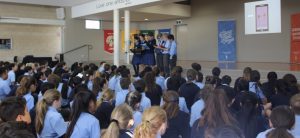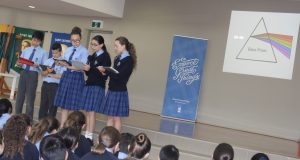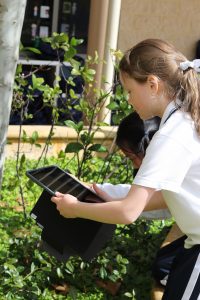

Innovation and Technology
 iHour
iHour
On Thursday morning, September 20, all students who had participated in iHour for Term Three were given the chance to present their innovative solutions for various problems in the world in front of their peers and parents. Well done to all Term Three iHour students for presenting your ideas confidently to the audience. We are looking forward to seeing these ideas come to life one day!
YEAR FOUR
Chloe, Austin, Campbell, Kaila and Maddison
Hear Clear: Smart headphones for everyday use
Sang, Zara I, Chase, Jett and Lillian Auto Pet Feeder: A simple solution to make caring for your pets easier
Auto Pet Feeder: A simple solution to make caring for your pets easier
Thomas, Bryant, Eva, Cyara and Joanna
Lock It: Re-designed chairs to make airport wait time more comfortable
Zara, Vanessa, Jon, Robert, Alissa and Cate
Find My Food: A helpful app to locate where certain grocery items are in the store
YEAR FIVE
Madison, Lydia, Mathia, Marcus, Sophia and Sophie
Spray & Defend: An anti-graffiti spray to protect your house from vandals
Emilia, Emily, Kieran, Kristy and Rosaria
Suck It Up: A vacuum style bin to prevent fly away rubbish
Jacob, Jazmyn, Lilliana, Lucas and Emma
Soltric: A car that runs off solar and is better for our environment
Olivia, Grace, Veronica, Joseph and Anton
PipeItUp: A water finding solution for drought stricken farmers
YEAR SIX
Grace, Annabelle, Domenica, Joseph and Van
MicroSport: An app and interactive hologram teaching you the latest sports skills and drills
Katie, Marcus C, Terry, Alana and Amara
iSight: Smart glasses that give voice commands to blind people to help them navigate day to day life
Victoria, Natalie, Alexsia, Deni, Sofia and Shanice
Bonus for the Homeless: Portable shelters for the homeless
Tina, Amelia, Krystelle, Sarah S and Nicholas
Sleeping Beauty: A combination nightlight and wristband to help you maintain healthy sleeping habits
Screen Time
Did you know that not all screen time is equal and children can have cognitive benefits out of their screen time if approached correctly? Current Screen Time recommendations are based on the sum of all screen-related activities. However, there is emerging evidence that suggests computer use and video game play should not be classed as the same type of activity as TV viewing.
PASSIVE SCREEN TIME
Passive consumption is when an individual passively absorbs information from the screen or consumes an app or a game through mindless repetition. Passive activities can include monitoring social media, watching videos on Youtube (especially if autoplay is on, i.e. the next video is not watched for any reason other than that it was offered), playing repetitive games and binge watching shows.
The main characteristic of passive screen time is that no thought, creativity or interaction is required to progress. At Infant Jesus School our lessons are carefully crafted to ensure that passive screen time is kept to a minimum and never occurs on individual devices.
ACTIVE
Active screen time, on the contrary, involves cognitive and/or physical engagement in the process of device usage. This might include activities like making movies, creating books, designing presentations or coding a website. Students are expected to reply, draw a picture, create or move. More than that, language, social and physical skills are developing. In fact, any application that involves effort on the part of the child has an educational side which promotes learning.
There has been a substantial body of research that documents the benefits of Active Screen Time in terms of cognitive skills and development. Computer use during the preschool years is associated with improvements in school readiness and cognitive  development (Li & Atkins, 2004) and higher levels of attention and motivation (McCarrick & Li, 2007), while the instant feedback scaffolds children’s interactions (Shute & Miksad, 1997). Computers facilitate social interaction and provide an environment for young children to use large amounts of language (McCarrick & Li, 2007) and improve word knowledge and verbal fluency (Shute & Miksad, 1997).
development (Li & Atkins, 2004) and higher levels of attention and motivation (McCarrick & Li, 2007), while the instant feedback scaffolds children’s interactions (Shute & Miksad, 1997). Computers facilitate social interaction and provide an environment for young children to use large amounts of language (McCarrick & Li, 2007) and improve word knowledge and verbal fluency (Shute & Miksad, 1997).
The same program can be passive or active depending on how it is used. At Infant Jesus School we believe that technology should be used for creation, not consumption and our teachers carefully program their use of technology to ensure it is used to enhance learning outcomes.
Technology often gets a bad rap for making kids into zombies, but there are many different ways to make your child’s technology use creative! If you are interested in your child using their device actively, consider some of the following activites
1.Make a Movie
The apps iMovie and Clips are simple movie making programs that allow your child to become actors, actresses and directors. Movie making is a genre of story telling and will help to build upon your child’s understanding of narratives. Additionally, challenge your child to make a documentary on an topic they are interested in or film a review of a favourite book or movie. Making a movie will help refine their understanding of the topic.
2. Use a Green Screen
While you are filming your movies, use the Doink Green Screen app to turn it into a block-buster with the aid of a green sheet and this innovative app. Film your scene in front of a green screen, then layer your background on top if it to create an awesome special effect! Export your video to the Camera Roll and it is ready to be edited further or combined with more clips in iMovie.
3. Become an Author
One of the best uses for the iPad is digital storytelling apps, and they don’t come much better than Book Creator for iPad. You can add text, images, video, audio and more. Choose from over 50 fonts, draw your own illustrations, and even publish your finished product to the iBook store.
#ExpectGreatThings


© Infant Jesus School 2017
17 Smith St, Morley WA 6062
Tel: (08) 9276 1769 | Fax: (08) 9276 2998
Website by Chameleon Logic








